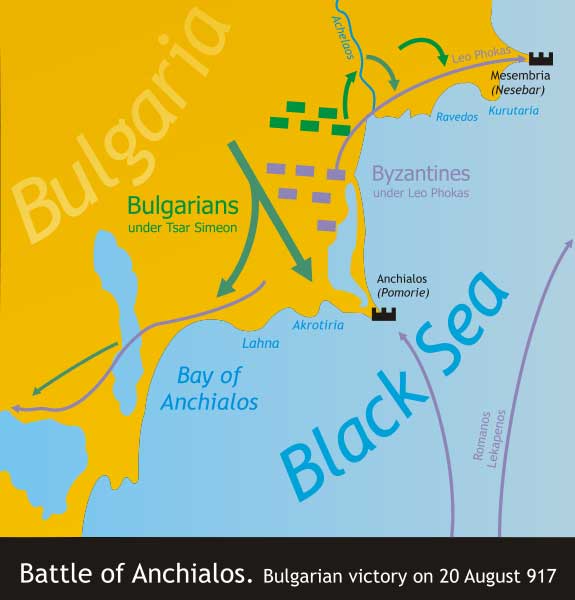.

Battle of Anchialus, Map by Todor Bozhinov
| Battle of Anchialus (917) | |
|---|---|
| Conflict: Byzantine-Bulgar wars | |
| Date: August 20, 917 | |
| Place: Anchialus | |
| Outcome: Bulgar victory | |
| Combatants | |
| Byzantine Empire | Bulgaria |
| Commanders | |
| Leo Phocas | Simeon the Great |
| Strength | |
| c.110,000 | 70,000 |
| Casualties | |
| 70,000 | Unknown |
The Battle of Anchialus (Anchialos) refers to three battles between Bulgaria and the Byzantine Empire.
The first battle took place in 708. Bulgarian Khan Tervel routed the force of Byzantine emperor Justinian II and reaffirmed his right to the region of Zagora in present-day south-east Bulgaria.
In the second battle, in 763, Byzantine emperor Constantine V with 9000 cavalry defeated the Bulgarians under Telets. Telets was assassinated after the defeat.
The third and most important battle took place on August 20, 917, on the Black Sea coast near the Bulgarian fortress of the same name.
In 914 the Bulgarians had captured Adrianople, while the Byzantine army was occupied in the east. In 917, the empire had stabilized its eastern borders, and the generals John Bogas and Leo Phocas were able to gather additional troops from Asia Minor, perhaps as many as 110,000. Romanus Lecapenus commanded the fleet at the mouth of the Danube. The Bulgarians, under Simeon the Great, had an army of only 70,000 men. The Bulgarians were afraid that the old allies of the Byzantines, the Pechenegs and the Hungarians, would attack them from the north, so two small Bulgarian armies were sent to protect the northern borders of the vast Bulgarian empire that spread from Bosnia in the west to Moldova in the east. John indeed tried to pay the Pechenegs to attack, but Romanus would not agree to transport them across the Danube, and instead they attacked Bulgarian territory on their own.
The battle was fought furiously. The decisive moment came when a cavalry corps of Bulgarians, led by Simeon himself, attacked the Byzantine left wing from behind the hills. It is estimated that approximately 70,000 Byzantine soldiers died in this battle. The Byzantine historian Paulus Deakon says that 75 years after this military catastrophy the field at Anchialus was still covered with tens of thousands of Roman skeletons.
The remainder of the Byzantine army fled all the way back to Constantinople, followed by the Bulgarians, who defeated John again outside the city. The Byzantines proposed a new peace treaty, and Simeon entered the imperial city and was crowned for a second time as "Tsar" (the Slavonic title for "Caesar") "of all Bulgarians and Greeks". Simeon also demanded that his daughter marry Constantine, the son of empress Zoe Karvounopsina, but Zoe refused and allied with Serbia and Hungary against him. However in August of 918, the general Romanus engineered a coup to depose Zoe and confine her to the monastery of St Euphemia-in-Petrium, allowing him to assume the purple.
| Ancient Greece
Science, Technology , Medicine , Warfare, , Biographies , Life , Cities/Places/Maps , Arts , Literature , Philosophy ,Olympics, Mythology , History , Images Medieval Greece / Byzantine Empire Science, Technology, Arts, , Warfare , Literature, Biographies, Icons, History Modern Greece Cities, Islands, Regions, Fauna/Flora ,Biographies , History , Warfare, Science/Technology, Literature, Music , Arts , Film/Actors , Sport , Fashion --- |
Retrieved from "http://en.wikipedia.org/"
All text is available under the terms of the GNU Free Documentation License
Hellenica World - Scientific Library

